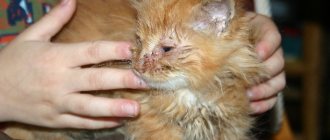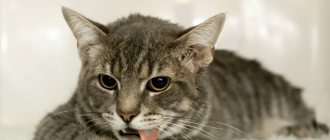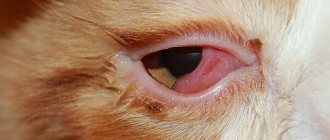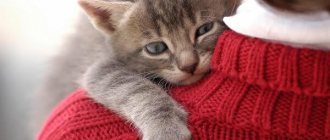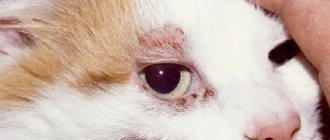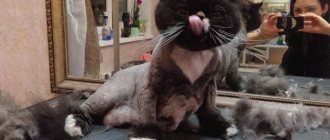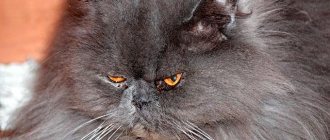Save article:
A cat's life is not always smooth sailing. The reasons that cause nervousness, tension or aggression in a furry pet are different. Any sign of stress in a cat is a danger signal. An animal in this state requires help, since the consequences of an unbalanced emotional background can manifest itself in the form of serious health problems.
Common Causes of Stress in Cats
global $ads_google; //data-ad-slot=”2475549904″ $ads_google = empty($ads_google) ? false : true; ?> if ($ads_google == false) {?>
$ads_google = true; ?> } ?>
Stress is a psychological reaction in response to a negative change in living conditions. A pet living in a loving and calm, stable environment rarely experiences emotional turmoil. However, any factor that disrupts his measured life can cause severe suppression or, conversely, hyperactivity.
The tension that arises in the nervous system manifests itself at the physical, psycho-emotional and behavioral level. The reasons that cause stress in a cat may be related to a change in environment, illness, physiological changes, or irritants in the external environment.
Moving
Changing homes is one of the most stressful factors for cats. Familiar surroundings and familiar smells are a guarantee of safety for the animal. When moving, the pet perceives its new place of residence as a potential threat. He needs time and effort to familiarize himself with the new territory. If during this period you do not surround the cat with care, attention and objects familiar to him, the risk of a stressful situation is very high.
Emotional
Stress in a cat can cause strong emotions. The reasons for their occurrence lie in life circumstances. Melancholy is initiated by departure or change of owner, conflicts in the house, or putting an animal into foster care. A trip to the veterinarian is associated with danger and causes anxiety. The situation is aggravated if previous visits to the veterinary hospital were associated with pain and negative emotions.
Signs of stress may appear in a pet if a new four-legged neighbor has appeared in the family. Not all cats adequately accept a dog in the house; it can be difficult for two cats to get along in the same territory. Stress in a cat can take the form of jealousy, rejection, protest, and mischief. The reason for a surge of emotions can be swimming, getting a haircut, or participating in an exhibition.
Diseases and physiology
Psychological sensitivity increases during pregnancy and nursing kittens. The cat's entire attention is aimed at preserving the offspring, so she perceives any potentially dangerous factor very acutely. Temporary physical incapacity of a pregnant female also leaves its mark when she cannot fully ensure her safety.
Special causes include illness. Any blow to health affects the psychological state. The animal becomes physically and emotionally more vulnerable. The inability to stand up for itself due to physical disability puts the cat under stress. Even problems such as fleas, ticks, worms, and fungal dermatitis can provoke itching, increased excitability, or, conversely, severe depression.
If your pet experiences pain or discomfort due to illness, the risk of stress increases significantly.
External factors
External reasons include home renovations, extraneous noise, changing furniture, parties with a large number of guests. Excessive fuss, strong odors, harsh sounds - all this affects the cat’s nervous system, causing stress. The situation is aggravated if in such an environment the owner does not have enough time for attention and affection for the animal. Even a short-term unpleasant influence from the outside can cause severe fear in the animal. And if the irritating factor is repeated, then nervousness is guaranteed.
Symptoms of stress
You can find out that a cat is in an unbalanced psychological state by its characteristic signs. Experts distinguish three phases of stress in a cat: anxiety, resistance and exhaustion. Each stage is characterized by a certain strength of manifestation and its own symptoms of stress.
global $ads_google; //data-ad-slot=”2475549904″ $ads_google = empty($ads_google) ? false : true; ?> if ($ads_google == false) {?>
$ads_google = true; ?> } ?>
First stage
When a stress factor appears, the cat begins to experience anxiety. This stage often goes unnoticed by inattentive owners.
However, with close communication with your pet, you can still notice the first signs of stress. During this period, the cat experiences:
- decrease in body temperature;
- lowering blood pressure;
- cardiopalmus;
- shallow rapid breathing;
- tremor of the whole body or its individual parts;
- changes in appetite and taste preferences;
- increased licking of fur;
- excessive salivation;
- apathy or, conversely, aggression;
- frequent meowing, hissing, or other sounds;
- involuntary urination;
- ignoring the litter tray;
- occasional
diarrhea or constipation.
These signs of stress can appear together or be combined in different combinations.
Second stage
The resistance (counteraction) phase is associated with the body’s attempts to return to a physiologically normal state. If at this stage the owner recognizes the cause of stress in time and the irritant is eliminated, then the symptoms gradually disappear. The functioning of all body systems is restored, and the psycho-emotional background returns to balance.
If stress continues to affect the animal, the body tries to adapt to it. Energy consumption becomes more economical compared to the first stage. Changes occur at the endocrine and hormonal levels. Outwardly, it may seem that the cat is accustomed to the situation and is not suffering. In reality, the body’s metabolism changes dramatically at this time and the third phase of stress begins.
Third stage
global $ads_google; //data-ad-slot=”2475549904″ $ads_google = empty($ads_google) ? false : true; ?> if ($ads_google == false) {?>
$ads_google = true; ?> } ?>
Constantly keeping a cat under stress leads to the body's vital reserves being depleted. Functional systems cannot cope with increased load. A lack of proteins, fats, and carbohydrates provokes an increased consumption of one’s own reserves. Against this background, general exhaustion begins. Signs of stress at this stage are complete apathy, constant passivity, and a noticeable loss of appetite. The animal rapidly loses weight and dystrophy begins.
Acute stress conditions
It is very important to be able to distinguish between different emotional types in order to properly provide psychological assistance to the animal. An acute condition is expressed by the following symptoms:
- The pet freezes, but the body may shake slightly, as if in a chill.
- The animal may involuntarily wet itself or perform an act of uncontrolled defecation.
- The tail clings tightly to the body, the snakes descend to the head. and the mustache leans down onto the cheeks.
- The pupils become dilated.
- Breathing is frequent and short.
- Profuse salivation begins.
- The pet meows inwardly with a hiss, and even growls.
- An attack of aggression occurs when approached too close.
To calm the animal, it is enough to get rid of the source of irritation and the pet’s behavior will return to normal quickly and painlessly. In such situations, it is important to understand what exactly triggered the attack of stressful behavior.
Chronic stress
A constant or periodically occurring stress factor puts a cat in a state of chronic tension. The animal's behavior changes and there are signs of physiological disorders. The pet tries to hide in a secluded place where no one can disturb it. Solitude is accompanied by increased drowsiness, weakness, and reluctance to play or show any activity. At the same time, a cat may react inadequately and even aggressively to loud unexpected sounds.
Bouts of gluttony or, conversely, ignoring food also indicate an ongoing chronic process. Cats often begin to mark the house, defiantly leaving puddles in different rooms or even near the bowl. Thus, the animal tries to demonstrate its dissatisfaction or fear.
Biochemical changes occurring in the body contribute to hair loss. This is accompanied by an excessive desire for hygiene, which causes the cat to constantly lick itself. As a result of prolonged neurosis, bald spots appear on the body, the hair becomes dull and thins.
What are the dangers of stress for cats?
It has been scientifically proven that many serious disorders in an animal’s body begin against a background of fear and nervous disorders. Practice confirms, for example, that such a rare phenomenon as pulmonary edema occurs precisely against the background of severe mental shock. A veterinarian anesthesiologist talks in more detail about all the dangers of stress in cats:
Anorexia
Refusal to eat provokes a lack of nutrients necessary for the normal functioning of the body. First of all, the digestive system is impaired. Insufficient nutrition provokes disruptions in the functioning of the stomach, intestines, and liver. The risk of gastritis, ulcers, and skin diseases increases. Prolonged stress threatens complete exhaustion. Lack of nutrients initiates cellular catabolism. After complete consumption of fat reserves, the breakdown of body proteins begins. The animal becomes painfully thin.
Cystitis
The genitourinary system in cats, like in other living organisms, is subject to neurohumoral regulation. Inhibition processes in the nervous system contribute to urination disorders. As a result of a nervous disorder, the pet may miss timely urges to go to the toilet. In the presence of accompanying factors, urinary retention in the bladder contributes to the development of bacterial flora. This often causes cystitis. In such a situation, it is necessary to treat not only the cat’s nervous system, but also inflammation of the bladder.
Constipation
global $ads_google;
//data-ad-slot=”2475549904″ $ads_google = empty($ads_google) ? false : true; ?> if ($ads_google == false) {?> $ads_google = true; ?> } ?> Often, moving, the arrival of a new tenant in the house, or overexposure cause physiological constipation in a cat. Impaired intestinal motility is one of the common consequences of stress in cats. Chronic constipation, in turn, is dangerous due to colic, obstruction of the intestinal tube, and inflammation.
In some cases, stress in a cat increases gastrointestinal motility and manifests itself in the form of diarrhea.
Other consequences
Neuroses affect the immune system, which provides protection against viruses, pathogenic bacteria, and fungi. This is especially dangerous for small kittens, who, due to their age and incomplete immunization, are less resistant to various infections.
Neuroses threaten the cat's cardiovascular system. Rapid heartbeat, sudden rushes of blood due to attacks of fear, increased blood pressure contribute to the development of heart and vascular diseases. As a result, the general blood supply to the body is disrupted.
Can a cat die from stress?
Many owners do not attach much importance to cat fears, considering them temporary and harmless phenomena. In the first and second stages, when stress in a cat manifests itself in the form of behavioral and physiological symptoms, there is no threat to life. However, the third stage of neurosis is considered extremely dangerous for a pet. Metabolic disorders entail complete depletion of the body's internal reserves. A protracted pathological process that is ignored by the owner is dangerous and fatal.
Why does your pet need help?
When a cat is stressed, three of its body systems begin to work differently. These are the gastrointestinal tract (GIT), lymphatic system and adrenal glands:
- The gastrointestinal tract is responsible for ensuring that organs and tissues receive all the necessary nutrients. When stressed, absorption is impaired because the stomach contracts. As a result, the contents become acidic, and ulcers and erosions may appear. This in turn provokes vomiting and diarrhea. The pet refuses to eat and is losing weight.
- Stress depresses the lymphatic system, which means it leads to decreased immunity. In this state and at this time, the animal can “catch” any infection, and existing diseases worsen.
- If under stress the lymphatic system is depressed, then the adrenal glands, on the contrary, more actively produce hormones (cortisol and adrenaline). It all ends with severe depression in the cat. Everything that was previously pleasant for her (treats, affection, toys) becomes indifferent.
Treatment of stress in cats
To bring a cat out of stress, a set of measures is needed. It includes psychological assistance from the owner and medications. Most often, non-hormonal sedatives for stress are used in therapy. But first of all, it is necessary to identify the cause and, if possible, remove or reduce the impact of the stressor.
Psychological and behavioral therapy
The technique consists of increasing attention to the pet and using games. Animal psychologists recommend using the distraction method. The owner’s task is to switch the cat’s attention from the object of stress to the toy. It is most convenient in such a situation to use interactive moving objects.
Another technique is immersion, which is considered more difficult. Real stress conditions are created for the pet, but the situation is kept under control. This switch helps level out the symptoms of the previous disorder. But this method requires great care and scrupulousness on the part of the person, otherwise the animal’s condition can only worsen.
Training helps relieve stress. The artificial creation of obstacles and difficulties that need to be overcome physically forces the cat to mobilize its strength. If it is impossible to eliminate the cause of stress (for example, canceling a move), it is worth surrounding your pet with care and affection. Frequent stroking, talking to your pet, and offering your favorite treats help you get through the adaptation period faster.
Medication assistance
global $ads_google; //data-ad-slot=”2475549904″ $ads_google = empty($ads_google) ? false : true; ?> if ($ads_google == false) {?>
$ads_google = true; ?> } ?>
The modern range of medications used for neuroses in cats includes sedatives, vitamins, and preparations with pheromones. They are available in the form of drops, aerosols, and tablets. In pet stores you can find special collars with anti-stress impregnation.
The following have antidepressant effect:
- Bach flowers
. A set of homeopathic plant extracts with different effects. To relieve stress, essences from agrimony, aspen, clematis, poultry and other plants are recommended.
- Stop stress
. The sedative contains phenibut and extracts of peony, skullcap, motherwort, mint, hops, and valerian. Biologically active substances normalize brain functions.
- Cat Baiyun
. A natural remedy for stress from medicinal plants: mint, valerian, sweet clover, oregano, thyme, lemon balm. Available in tablet and liquid form.
- B vitamins
. They improve the conduction of nerve impulses and help normalize the psychosomatic state. Vitamins do not cure, but provide good support for anti-stress medications.
At home, it is easy to prepare herbal infusions and decoctions from soothing herbs (oregano, mint, lemon balm). Essential oils of plants are used as fragrances for the room in which the cat is located. The esters of lavender, neroli, mint, and bergamot have the best effect.
It is advisable to consult a veterinarian before starting treatment for stress with medications.
What to do?
If the manifestations of neurosis are not yet so strong, and the cat does not break into a gallop at the slightest sound or touch, you can simply leave him alone and let him sleep off. This often helps. In the case when the animal looks more like a hedgehog that has been hit by an electric current, “breaks down” for any reason and is ready to attack even a bull terrier, it’s time to put it in a transport cage and go to the veterinarian. As a rule, sedatives are prescribed, and in case of serious behavioral deviations and a tendency to “self-torture”, muscle relaxants must be administered.
In recent years, hormone therapy has come to the fore. Many drugs of this class have been created, with the help of which it is possible to successfully correct cat behavior. However, it is important to recall here that hormone treatment is a potentially dangerous event. Do not prescribe and use such products yourself, as otherwise you seriously risk the health of your cat.
Preventing cat stress
It is impossible to completely protect your furry pet from unpleasant factors. But it is within the power of a person to prepare an animal for possible stress. Prevention should begin when the kitten first appears in the house. To do this, various non-standard situations are created for the pet. But they must always be supervised by the owner. Traveling together, meeting new people, communicating with fellow animals - all this expands the emotional sphere of a cat.
A good way to prevent stress for a cat is constant communication. At the same time, games and affection should not be against the will of the pet, as this causes protest and discontent in him. Any travel, grooming event, move, or noisy holiday must be preceded by preparation. This could be the dosed use of a sedative, preliminary acquaintance with people or a new place.
If you follow all the rules of prevention, you can prevent the development of neurosis in your pet. If a critical situation does arise, then at the first symptoms of stress it is necessary to take urgent measures. Psychological assistance in combination with official therapy can relieve symptoms and bring the animal out of a stressful state.
global $ads_google;
//data-ad-slot=”2475549904″ $ads_google = empty($ads_google) ? false : true; ?> if ($ads_google == false) {?> $ads_google = true; ?> } ?>

